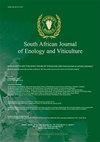不同刈割高度对葡萄机械修剪的影响。梅洛连续三个季节
IF 1.1
4区 农林科学
Q4 FOOD SCIENCE & TECHNOLOGY
引用次数: 3
摘要
各种葡萄园操作的机械化降低了生产成本和劳动力需求,从而能够更有效地管理更大的葡萄园。然而,修剪机制与产量下降(由于果位延伸出棚架系统区域而导致水果产量下降)、过度种植和产量不稳定有关。此外,对于大多数接受机械修剪的葡萄园来说,手动跟进是一种常见的做法。对梅洛葡萄园进行了连续三个季节的营养和生产方面的研究,并将手动修剪与机械交替修剪策略进行了比较。与机械修剪的葡萄相比,手工修剪的葡萄芽爆裂更成功。然而,与机械修剪相比,手工修剪耗时更长,产量更低。传统的高(警戒线以上25厘米)机械修剪在营养和产量参数方面表现出随时间推移而恶化的特征。在三个季节中的一个季节,在较低高度(警戒线上方12厘米)修剪的葡萄保持了高产。尽管产量较高,但果实可溶性固形物、pH值和可滴定酸度没有改变。侧枝第二茬果实的数量很少,各处理之间非常相似。在一个季节中,在较低高度进行机械修剪通常会降低年度潜在产量,但与仅使用传统的高机械修剪相比,多年来的平均和累积效果有所改善。这些长期效应使葡萄园修剪完全机械化并保持高产成为可能。本文章由计算机程序翻译,如有差异,请以英文原文为准。
Effect of Different Cutting Heights of Mechanically Pruned Grapevines cv. Merlot Over Three Consecutive Seasons
The mechanisation of various vineyard operations reduces production costs and labour requirements, thus allowing for the more efficient management of larger vineyards. However, pruning mechanisation has been associated with yield decline (a decrease in fruit production due to the elongation of the fruiting positions out of the trellis system area), over cropping and unstable yields. Furthermore, manual followup has been a common practice for most vineyards subjected to mechanised pruning. A Merlot vineyard was studied for three consecutive seasons in terms of its vegetative and productive aspects, and hand pruning was compared with mechanised alternating pruning strategies. Bud burst was more successful in hand-pruned vines compared to mechanically pruned vines. However, hand pruning took longer and produced a lower yield compared to mechanical pruning. Traditional high (25 cm above the cordon wire) mechanical pruning showed deteriorating characteristics over time in vegetative and yield parameters. Vines pruned at a lower height (12 cm above the cordon wire) in one of the three seasons maintained high production. Despite higher yields, fruit soluble solids, pH and titratable acidity were not altered. The quantity of second-crop fruit from lateral shoots was small and was very similar among treatments. Mechanical pruning at a lower height in one season in general reduces the annual potential yield, but the average and cumulative effects over the years improve compared to using just traditional high mechanical pruning. These long-term effects make it feasible to fully mechanise vineyard pruning and maintain high yields.
求助全文
通过发布文献求助,成功后即可免费获取论文全文。
去求助
来源期刊
CiteScore
2.50
自引率
7.70%
发文量
1
审稿时长
>36 weeks
期刊介绍:
The South African Journal of Enology and Viticulture (SAJEV) publishes full-length original Research Papers, Research Notes and Review Papers on all subjects related to enology and viticulture. The SAJEV does not accept articles published in, or submitted to, other journals.

 求助内容:
求助内容: 应助结果提醒方式:
应助结果提醒方式:


